![[Brain Image]](../graphics/head_space.gif)
PSY 340 Brain and Behavior
Class 28: What is An Emotion? [Outline]
|
|
PSY 340 Brain and Behavior Class 28: What is An Emotion? [Outline] |
|
How would you answer the question below that psychologist Dacher Keltner (2019) poses to his classes?
“If you could flip a switch and shut off the experience of emotion,
all emotions, from that moment going forward, would you?”
Now, whatever your answer to the question, what is the reason for your answer???
Hierarchy of Terms used in Psychology
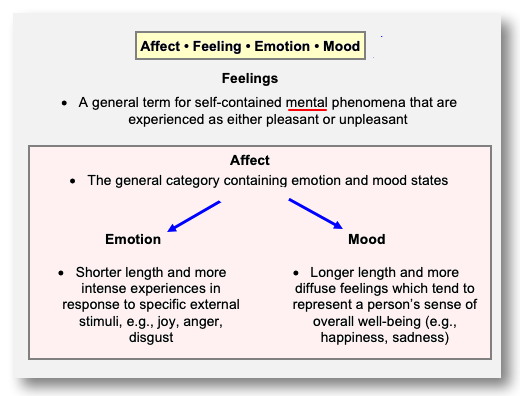
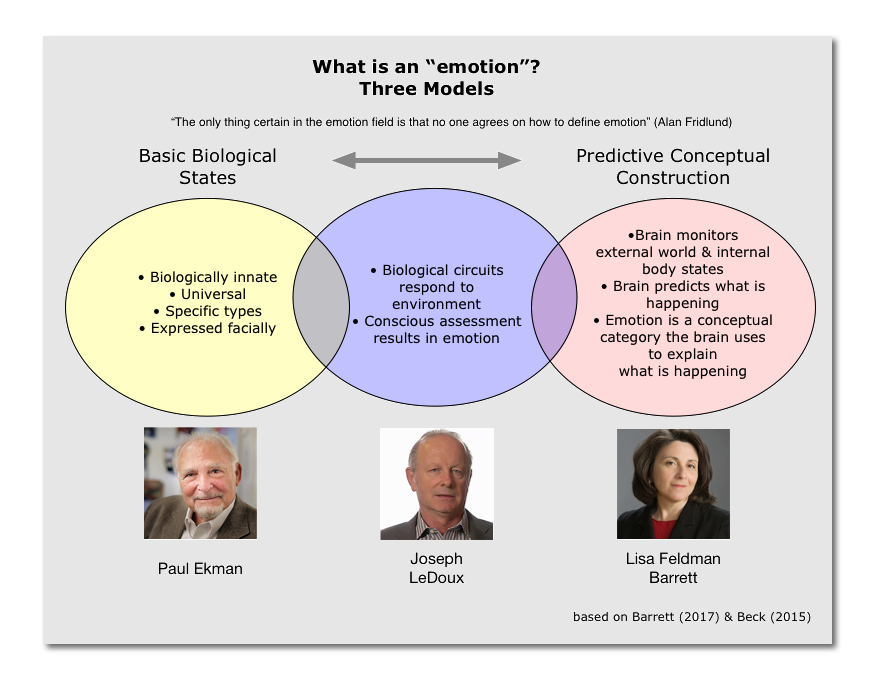
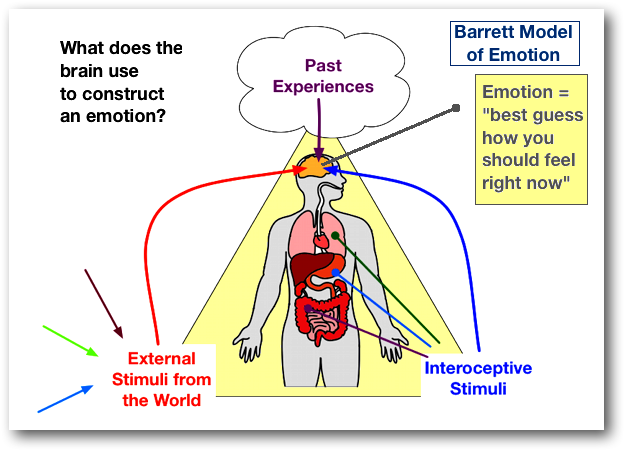
Many psychologists argue that an emotion comprises three different elements:
- cognitive (thinking) component: an appraisal or judgment
- feeling (subjective) component: what a person experiences privately
- action (or, action tendency) component: either an action or, at least, a tendency to an action
1. Emotions, Autonomic Nervous System Arousal, and the James-Lange Theory
- Emotions arouse the autonomic nervous system – sympathetic ("flight or flight") and parasympathetic ("restoration and relaxation")
- Walter B. Cannon, MD was the first to describe the "flight or fight" response as the body readies itself for a challenge.
So, how can we understand the ways in which the body and the emotions are connected?
Commonsense view:
James-Lange view:
Named for William James (1842-1910; American) & Carl Georg Lange (1834-1900; Danish)
A modern version of this theory says that emotions follow this pattern:
- Event or stimulus which challenges you
- Cognitive appraisal of the situation comes first
- This leads to action (we including our bodies do something; the behavioral- response) and then
- Emotional feeling follows after the action. Hence, an emotion is a kind of thought or conclusion.
A. Is physiological (ANS) arousal necessary for emotional feelings? The results are contradictory
- Evidence AGAINST needing ANS arousal
- People with paraplegia or quadraplegia (paralysis)
- Damage to right somatosensory cortex
- Evidence FOR needing ANS arousal
- Pure Autonomic Failure (PAF)
- BOTOX (Botulinum toxin)
B. Is physiological (ANS) arousal sufficient for emotions? Probably...but only in extreme cases
- Extreme Arousal
- Panic Disorder
- Effects of Facial Expression on Emotion
- Facial Feedback Hypothesis
- 1988 study vs. E.-J. Wagenmakers at the University of Amsterdam and his colleagues (2016) vs. Coles et al. (2019) meta-analysis (= hypothesis is real, but the effects are small and variable)
- Möbius syndrome
Bottom Line: The perception of the body's reactions may be somewhat important for us to interpret our feelings.
C. Is Emotion a Useful Concept?
- As indicated at the beginning, Barrett argues that the classical biological approach to emotion is not true. Emotions are made, not simply uncovered, as a reaction to experience.
The "triune brain" model [brainstem = survival; limbic system = emotional brain; neocortex = rational control of emotions] was proposed in the mid-20th century. Limbic System = amygdala, cingulate cortex, hippocampus, fornix, various nuclei (septal, mammillary body), and parts of the thalamus & hypothalamus.
- Research in the late 20th and early 21st century has shown that the "triune brain" model is wrong (even though it is a widely known psychological myth).
- Multiple areas of the brain seem to be involved in processing multiple forms of emotion including both the limbic and cortex.
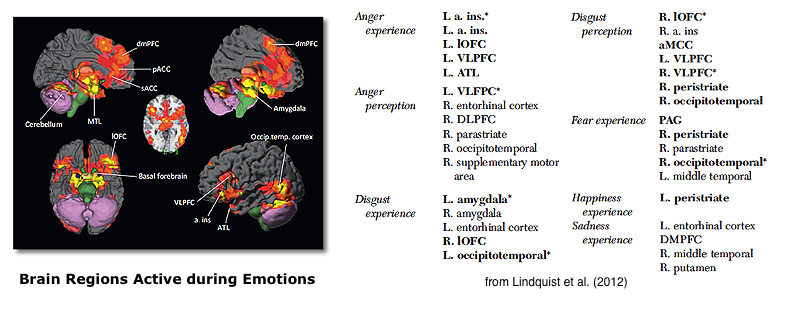
2. Do People Have A Limited Number of Basic Emotions
Paul Ekman : happiness, sadness, anger, fear, disgust, and surprise.
- Facial Expression identification worldwide: 58% accurate
- Ekman (1999) expanded his listing of basic emotions to others which are not subject to facial display: these include amusement, contempt, contentment, embarrassment, excitement, guilt, pride in achievement, relief, satisfaction, sensory pleasure, and shame.
Other psychologists argue that Ekman's evidence is weak: what about the 42% incorrect responses? Or, people seeing more than one emotion in a single photograph? Or, the reality that we observe more of a person than their face alone?
Jeffrey Grey's Reinforcement Sensitivity Theory
Brain Hemispheres and Emotion
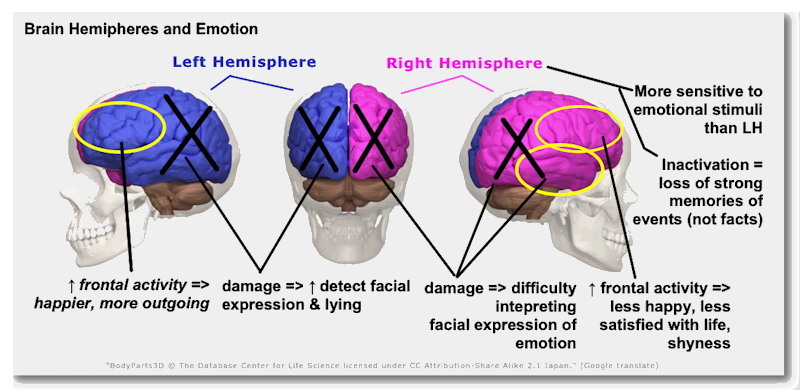
Positive Emotions: A listing of those being studied in recent years include amusement, awe, contentment, desire, ecstasy, gratitude, interest, joy, love, pride, relief, sympathy, & triumph (Keltner, 2019). An alternative group of positive emotions are shown below in the figure.
Broaden-and-Build Theory of Positive Emotions of Barbara Fredrickson
- Broadening or increasing the number of potential "thought-action" responses
- Undo the effects of short-term negative emotions
- Fueling psychological resiliency for people who are coping with chronic stress
3. The Function of Emotions
A. Moral Decisions and Emotions
![[Trolley Car Dilemma]](../graphics/dilemma.trolley.jpg)
Our text also proposed two other scenarios
The Lifeboat Dilemma
The Hospital Dilemma
- we may conclude that decision-making is not purely a "logical" process.
Joshua Green (Harvard University):, when we make decisions, we activate different brain areas if the decision is laden with emotion.
- Cingulate gyrus
- Angular gyrus
- Medial frontal gyrus
B. Brain Damage, Emotions, and Decision-making
Old notion = Emotions disrupt or harm higher forms of reason
New notion = Individuals with brain damage affecting their emotions make very poor decisions (Antonio Damasio)
Case #1: Man with prefrontal cortex damage
- No emotions felt & he got neither pleasure nor pain from anything
- He knew what the outcomes would be for different actions. But, he could not choose which to do because it was not clear to him whether he preferred a "good" or a "bad" outcome.
Case #2: Young adults who suffered injury to prefrontal cortex in infancy.
- Never learned moral behavior: stole, lied, abused others, etc. No guilt.
- No friends and could not hold jobs.
- Similar to findings of Dr. Dorothy Otnow Lewis among juveniles and adults sentenced to death for murder (Lewis, 1998, 2004). She consistently found histories of significant brain trauma in such convicts.
Current notion = Emotions provide wisdom and shape thinking in deeply rational ways
The first version of this page was posted on April
5, 2005.